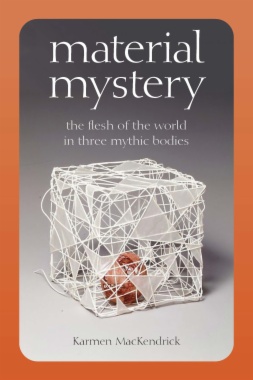Material Mystery considers three apparently anthropocentric myths that are central to Abrahamic religions—those of the primal human, the incarnated and possibly divine redeemer, and the resurrected body. At first glance, these stories reinforce a human-centered theology and point to a very anthropomorphic God. Taking them seriously seems to ignore the material turn in the humanities entirely, with the same sort of willful ignorance that some of our politicians show in declaring that their myths count as facts, or that the point of the rest of the world is to further human consumption.
But it is possible, Karmen MacKendrick shows, to read these figures through a particular tradition that emerges from the Hebrew Bible, the tradition of Wisdom as a creative force. Wisdom texts are common across the ancient Near East. As the idea of creative Wisdom develops from antiquity into the middle ages, it gathers philosophical influences from a range of philosophical traditions. This exuberantly promiscuous impurity—intellectual, artistic, and theological—generates new interpretive possibilities. In these interpretations, each human-like figure opens up onto the world''s matter, as an interdependent part of it, and matter is thoroughly mixed with divinity. Such mythic readings complement our factual, scientific understanding of the material world, to engage wider kinds of knowing and affective attention—particularly Wisdom''s combination of care and delight.
- Cover�������������������������������
- MATERIAL MYSTERY����������������������������������������������������������������
- Title�������������������������������
- Copyright�������������������������������������������
- Dedication����������������������������������������������
- Contents����������������������������������������
- Introduction: New Materialism, Old Wisdom�������������������������������������������������������������������������������������������������������������������������������������������
- 1 Complex Truth: Myth, Facts, and Matter����������������������������������������������������������������������������������������������������������������������������������������
- 2 Adam’s Skin: The Strangely Bounded Primal Person����������������������������������������������������������������������������������������������������������������������������������������������������������������������
- 3 Limitless Bounding: The Valentinian Body of Christ����������������������������������������������������������������������������������������������������������������������������������������������������������������������������
- 4 Glorious Return: Resurrected Bodies�������������������������������������������������������������������������������������������������������������������������������
- Afterword�������������������������������������������
- ACKNOWLEDGMENTS�������������������������������������������������������������
- NOTES�������������������������������
- BIBLIOGRAPHY����������������������������������������������������
- INDEX�������������������������������

